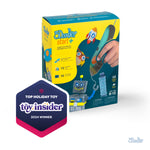STEM: Stars and Constellations
In this activity, students will work in pairs to research what causes the apparent brightness of stars and constellations. Students will write a fact-based argument to respond to this question and then create a model of a selected constellation with a 3Doodler and glow in the dark plastic sticks.

KnowledgeStudents haveread about stars and constellations.
a basic understanding of stars and constellations.
practiced with the 3Doodler.
read about stars and constellations.
a basic understanding of stars and constellations.
practiced with the 3Doodler.
ObjectivesStudents willrecognize constellations change.
identify how constellations interact with the Earth.
understand why constellations seem to change over a series of nights.
construct a stencil and model of a selected constellation with a 3Doodler.
understand the associated story of their constellation.
recognize constellations change.
identify how constellations interact with the Earth.
understand why constellations seem to change over a series of nights.
construct a stencil and model of a selected constellation with a 3Doodler.
understand the associated story of their constellation.
MaterialsStudents will need3Doodler
Glow in the dark plastic for 3Doodler
Eco Plastic for 3Doodler
pencil (1 per student)
chalk (1 per group)
white paper (1 per group)
black paper (1 per group)
3Doodler
Glow in the dark plastic for 3Doodler
Eco Plastic for 3Doodler
pencil (1 per student)
chalk (1 per group)
white paper (1 per group)
black paper (1 per group)
Lesson PlanInstructions
Step 1 - PREPARATIONRead the story behind a selection of the constellations: Hercules, Cassiopeia, Ursa Major, Ursa Minor, Orion, Scorpius, Taurus and/or Draco. Select constellations and read about them online here.
Step 2Share the guiding question for this lesson: “What causes the apparent brightness of stars and constellations?”
Step 3Instruct students to have a brainstorming session with all they know about stars and constellations. Record their responses on the board.
Step 4Define the term star: A star is a huge cloud of gas. Most stars are hundreds of thousands of times bigger than Earth. They are trillions of miles away from Earth.
Step 5Define the term constellation: Patterns of stars and the space between and around them. Astronomers have identified 88 constellations.
Step 6Share the two-part goal: 1) Students will design stencils for constellations and then 3Doodle them using glow in the dark plastic sticks. 2) Students will write a fact-based argument based on research, which answers the guiding question.
Step 7Model how to safely research about constellations online. Instruct students to begin by watching the PCS video, Star Gazers, and ask them to record notes.
Step 8Demonstrate how to create a stencil and 3Doodle model of the selected constellation.
*See Appendix
Step 9Divide students into groups of 2-3 and have each group select a constellation: Hercules, Cassiopeia, Ursa Major, Ursa Minor, Orion, Scorpius, Taurus or Draco.
Step 10Allow students time to research their constellation and gather facts to compile information about their constellation, and draft a fact-based argument to the guiding question.
Step 11Hand out white and black paper, chalk, pencils, and 3Doodlers. Allow students time to create stencils and trace with 3Doodler.
*See Appendix
Read the story behind a selection of the constellations: Hercules, Cassiopeia, Ursa Major, Ursa Minor, Orion, Scorpius, Taurus and/or Draco. Select constellations and read about them online here.
Share the guiding question for this lesson: “What causes the apparent brightness of stars and constellations?”
Instruct students to have a brainstorming session with all they know about stars and constellations. Record their responses on the board.
Define the term star: A star is a huge cloud of gas. Most stars are hundreds of thousands of times bigger than Earth. They are trillions of miles away from Earth.
Define the term constellation: Patterns of stars and the space between and around them. Astronomers have identified 88 constellations.
Share the two-part goal: 1) Students will design stencils for constellations and then 3Doodle them using glow in the dark plastic sticks. 2) Students will write a fact-based argument based on research, which answers the guiding question.
Model how to safely research about constellations online. Instruct students to begin by watching the PCS video, Star Gazers, and ask them to record notes.
Demonstrate how to create a stencil and 3Doodle model of the selected constellation.
*See Appendix
Divide students into groups of 2-3 and have each group select a constellation: Hercules, Cassiopeia, Ursa Major, Ursa Minor, Orion, Scorpius, Taurus or Draco.
Allow students time to research their constellation and gather facts to compile information about their constellation, and draft a fact-based argument to the guiding question.
Hand out white and black paper, chalk, pencils, and 3Doodlers. Allow students time to create stencils and trace with 3Doodler.
*See Appendix
Wrap Up
Assessment
Possible Extensions
Resources
Tips for the Project
1) Draw or copy an image of the individual or creature associated with the constellation.
2) Cover the back of the drawing or copy with chalk in any light color.
3) Place the original drawing (face up) over black paper. Use a pen to retrace your lines. You will be left with an outline in chalk on your black paper.
4) Use 3Doodler to trace over chalk lines of individual or creature.
5) Refer to the constellation, then to add glow in the dark plastic with the 3Doodler. Add stars as points first, then attach points lifting the line of plastic as you go, and anchoring it at the beginning and end point of each line segment.
Reference Image 1
Reference Image 2
Reference Image 3
Reference Image 4
Vocabulary
art - the quality, production, expression, or realm, according to aesthetic principles, of what is beautiful, appealing, or of more than ordinary significance.
circumpolar stars - a star, as viewed from a given latitude on Earth, that never sets below the horizon due to its apparent proximity to one of the celestial poles.
collaboration - to work jointly with others or together especially in an intellectual endeavor.
constellation - any of various groups of stars to which definite names have been given, as Ursa Major, Ursa Minor, Boötes, Cancer, Orion.
design - to prepare the preliminary sketch or the plans (for a work to be executed), especially to plan the form and structure of an object, building, bridge, etc...
drawing - the art or technique of representing an object or outlining a figure, plan, or sketch by means of lines.
observation - an act or instance of noticing or perceiving.
problem-solving - the process or act of finding a solution to a problem.
seasonal stars - stars that are only visible for a portion of the year doe to their position in relation to the earth and the earth's rotation.
shapes - the quality of a distinct object or body in having an external surface or outline of specific form or figure.
star - any of the large, self-luminous, heavenly bodies, as the sun, Polaris, etc.
sun - the star that is the central body of the solar system, around which the planets revolve and from which they receive light and heat.
Educational Standards
Draw on information from multiple print or digital sources, demonstrating the ability to locate an answer to a question quickly or to solve a problem efficiently. (5-ESS1- 1)
Students will research to respond to the guiding question: “What causes the apparent brightness of stars and constellations?”
Integrate information from several texts on the same topic in order to write or speak about the subject knowledgeably. (5-ESS1- 1)
Students will use various print and digital resources to respond to the guiding question: “What causes the apparent brightness of stars and constellations?”
Support an argument that the apparent brightness of the sun and stars is due to their relative distances from the Earth.
Students will research and write a fact-based argument to support their response to the guiding question: “What causes the apparent brightness of stars and constellations?”
Plan and create a design document to illustrate thoughts, ideas, and stories in a sequential (step-by- step) manner (e.g., story map, storyboard, sequential graphic organizer).
Students will create sketches and stencils while planning a model of their selected constellation.
Decompose (break down) a larger problem into smaller sub-problems with teacher guidance or independently.
Students will break down the process of formulating a response to the guiding question through research, analysis, synthesis and reflection.
Use technology to seek feedback that informs and improves their practice and to demonstrate their learning in a variety of ways.
Students will use the 3Doodler to create a model of a selected constellation.
Create original works or responsibly repurpose or remix
digital resources into new creations.
Students will use a 3Doodler to create a dimensional model of a constellation.
Use collaborative technologies to work with others, including peers, experts or community members, to examine issues and problems from multiple viewpoints.
Students will seek feedback from peers during their research, writing, design and 3Doodler modeling.





